Strategic Analysis of Lidl's International Business Management: Mexico
VerifiedAdded on 2021/04/17
|26
|5092
|86
Report
AI Summary
This report provides a strategic analysis of Lidl's potential international expansion into Mexico. It begins with an introduction to strategic business management and a background on Lidl, a discount supermarket chain. The report then discusses the rationale for selecting Mexico as a target market, highlighting its economic potential, FDI trends, and retail market characteristics. A key component of the report is the application of Porter's Five Forces model to assess the competitive intensity of the Mexican retail environment, analyzing the bargaining power of buyers and suppliers, competitive rivalry, the threat of new entrants, and the threat of substitutes. Further, the report critically evaluates Lidl's resources and capabilities using the VRIO framework to assess its competitive advantages in the Mexican market. Finally, the report evaluates various modes of entry available to Lidl, recommending a specific approach with justification. The report concludes with a summary of the key findings and recommendations for Lidl's strategic international business management in Mexico.
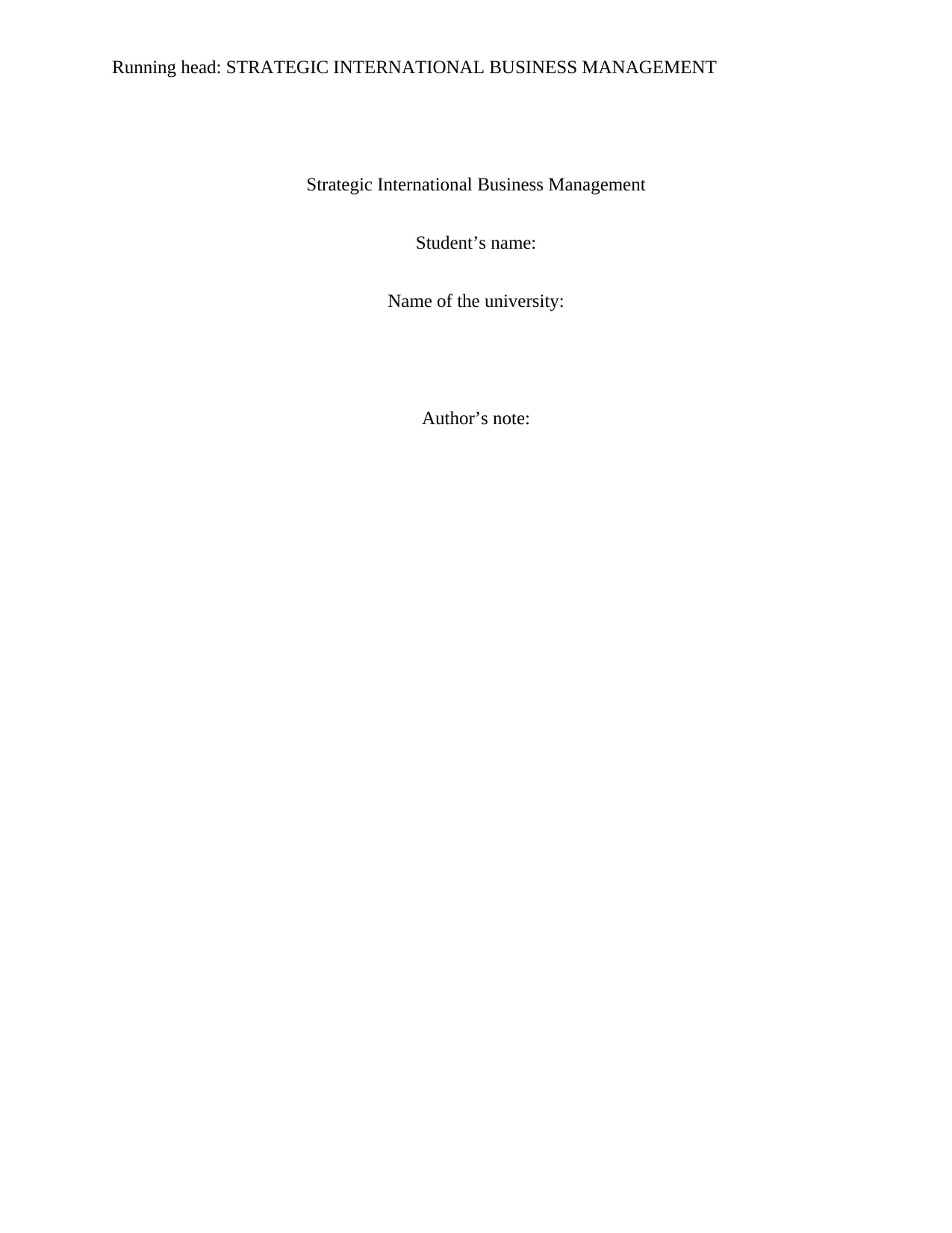
Running head: STRATEGIC INTERNATIONAL BUSINESS MANAGEMENT
Strategic International Business Management
Student’s name:
Name of the university:
Author’s note:
Strategic International Business Management
Student’s name:
Name of the university:
Author’s note:
Paraphrase This Document
Need a fresh take? Get an instant paraphrase of this document with our AI Paraphraser
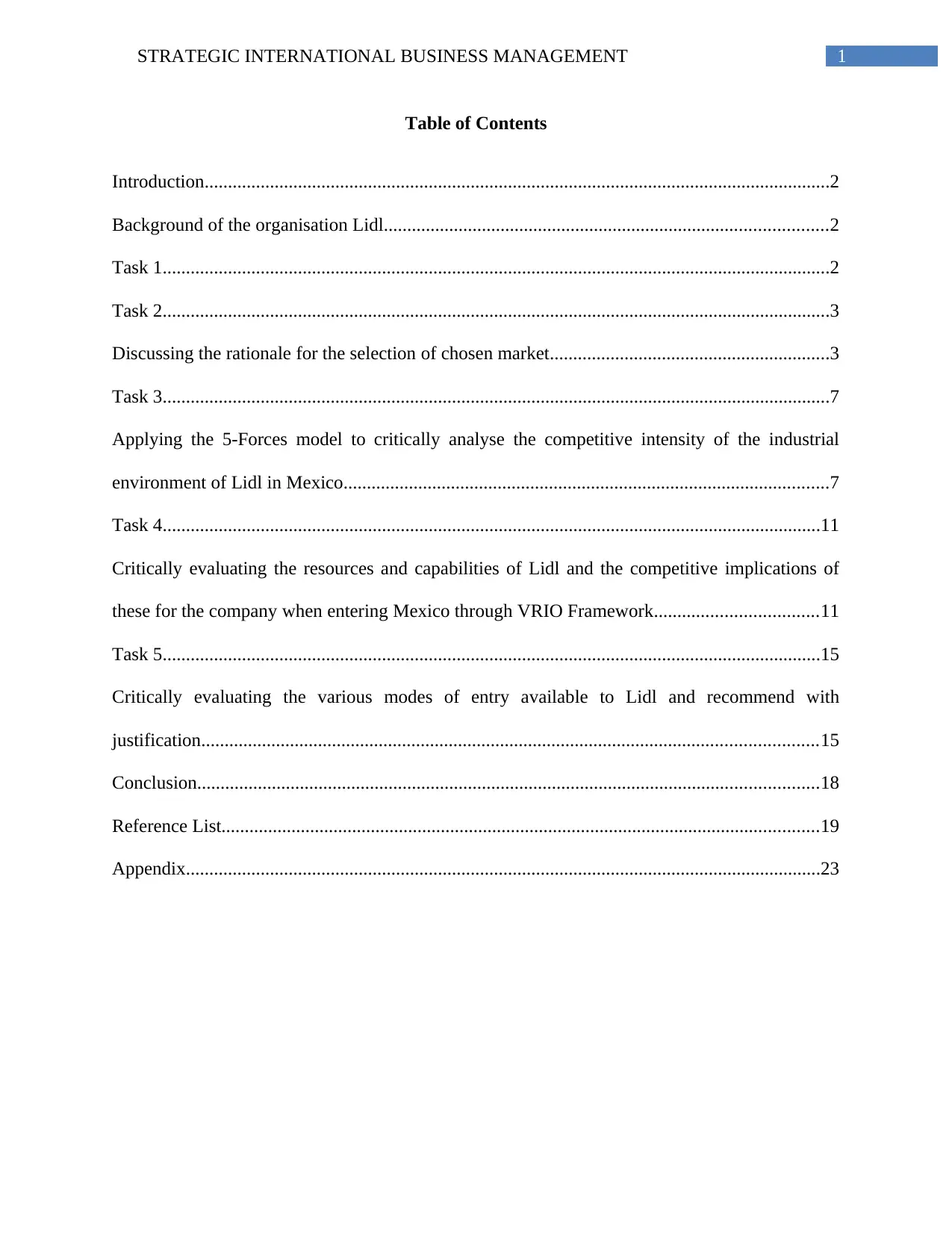
1STRATEGIC INTERNATIONAL BUSINESS MANAGEMENT
Table of Contents
Introduction......................................................................................................................................2
Background of the organisation Lidl...............................................................................................2
Task 1...............................................................................................................................................2
Task 2...............................................................................................................................................3
Discussing the rationale for the selection of chosen market............................................................3
Task 3...............................................................................................................................................7
Applying the 5-Forces model to critically analyse the competitive intensity of the industrial
environment of Lidl in Mexico........................................................................................................7
Task 4.............................................................................................................................................11
Critically evaluating the resources and capabilities of Lidl and the competitive implications of
these for the company when entering Mexico through VRIO Framework...................................11
Task 5.............................................................................................................................................15
Critically evaluating the various modes of entry available to Lidl and recommend with
justification....................................................................................................................................15
Conclusion.....................................................................................................................................18
Reference List................................................................................................................................19
Appendix........................................................................................................................................23
Table of Contents
Introduction......................................................................................................................................2
Background of the organisation Lidl...............................................................................................2
Task 1...............................................................................................................................................2
Task 2...............................................................................................................................................3
Discussing the rationale for the selection of chosen market............................................................3
Task 3...............................................................................................................................................7
Applying the 5-Forces model to critically analyse the competitive intensity of the industrial
environment of Lidl in Mexico........................................................................................................7
Task 4.............................................................................................................................................11
Critically evaluating the resources and capabilities of Lidl and the competitive implications of
these for the company when entering Mexico through VRIO Framework...................................11
Task 5.............................................................................................................................................15
Critically evaluating the various modes of entry available to Lidl and recommend with
justification....................................................................................................................................15
Conclusion.....................................................................................................................................18
Reference List................................................................................................................................19
Appendix........................................................................................................................................23
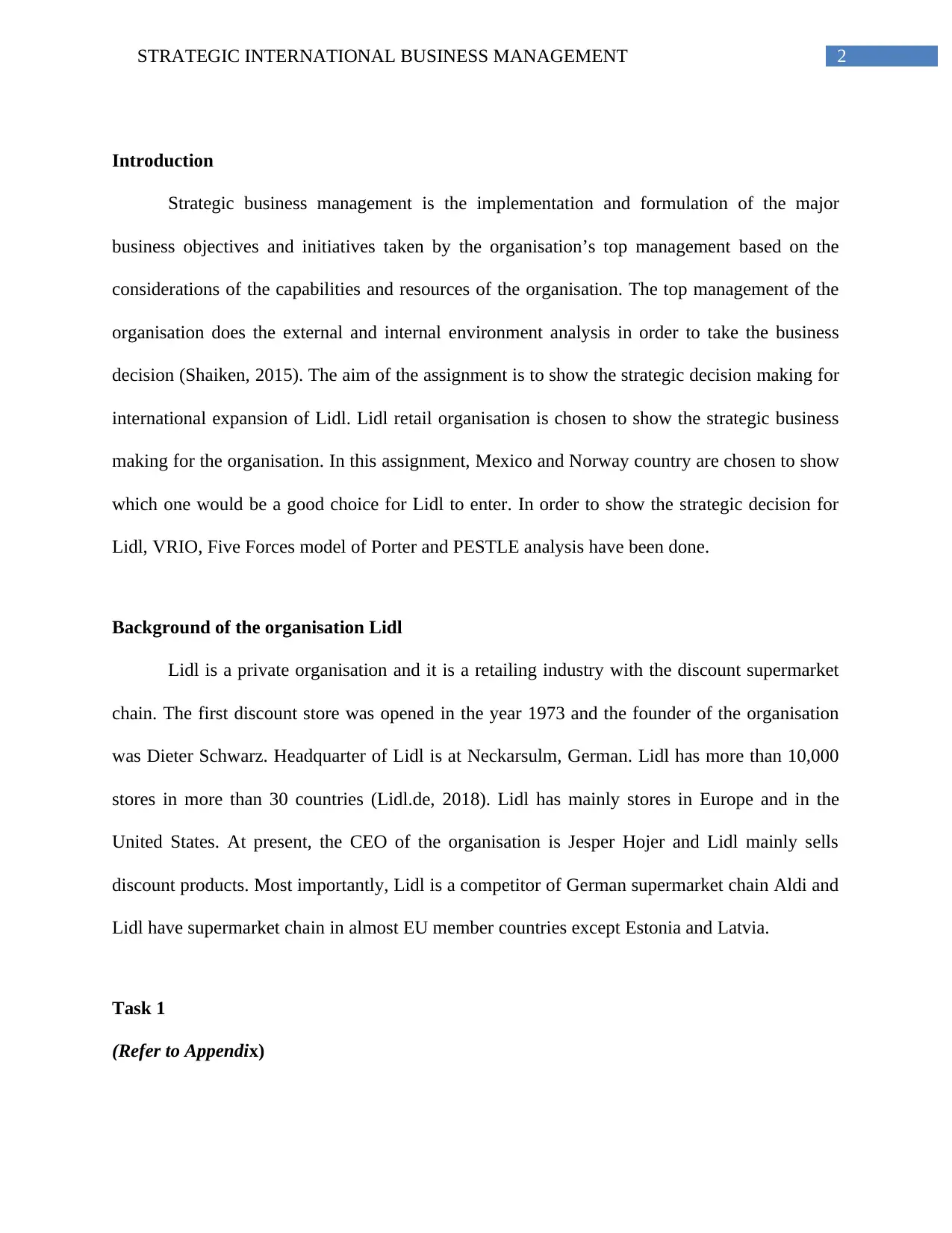
2STRATEGIC INTERNATIONAL BUSINESS MANAGEMENT
Introduction
Strategic business management is the implementation and formulation of the major
business objectives and initiatives taken by the organisation’s top management based on the
considerations of the capabilities and resources of the organisation. The top management of the
organisation does the external and internal environment analysis in order to take the business
decision (Shaiken, 2015). The aim of the assignment is to show the strategic decision making for
international expansion of Lidl. Lidl retail organisation is chosen to show the strategic business
making for the organisation. In this assignment, Mexico and Norway country are chosen to show
which one would be a good choice for Lidl to enter. In order to show the strategic decision for
Lidl, VRIO, Five Forces model of Porter and PESTLE analysis have been done.
Background of the organisation Lidl
Lidl is a private organisation and it is a retailing industry with the discount supermarket
chain. The first discount store was opened in the year 1973 and the founder of the organisation
was Dieter Schwarz. Headquarter of Lidl is at Neckarsulm, German. Lidl has more than 10,000
stores in more than 30 countries (Lidl.de, 2018). Lidl has mainly stores in Europe and in the
United States. At present, the CEO of the organisation is Jesper Hojer and Lidl mainly sells
discount products. Most importantly, Lidl is a competitor of German supermarket chain Aldi and
Lidl have supermarket chain in almost EU member countries except Estonia and Latvia.
Task 1
(Refer to Appendix)
Introduction
Strategic business management is the implementation and formulation of the major
business objectives and initiatives taken by the organisation’s top management based on the
considerations of the capabilities and resources of the organisation. The top management of the
organisation does the external and internal environment analysis in order to take the business
decision (Shaiken, 2015). The aim of the assignment is to show the strategic decision making for
international expansion of Lidl. Lidl retail organisation is chosen to show the strategic business
making for the organisation. In this assignment, Mexico and Norway country are chosen to show
which one would be a good choice for Lidl to enter. In order to show the strategic decision for
Lidl, VRIO, Five Forces model of Porter and PESTLE analysis have been done.
Background of the organisation Lidl
Lidl is a private organisation and it is a retailing industry with the discount supermarket
chain. The first discount store was opened in the year 1973 and the founder of the organisation
was Dieter Schwarz. Headquarter of Lidl is at Neckarsulm, German. Lidl has more than 10,000
stores in more than 30 countries (Lidl.de, 2018). Lidl has mainly stores in Europe and in the
United States. At present, the CEO of the organisation is Jesper Hojer and Lidl mainly sells
discount products. Most importantly, Lidl is a competitor of German supermarket chain Aldi and
Lidl have supermarket chain in almost EU member countries except Estonia and Latvia.
Task 1
(Refer to Appendix)
⊘ This is a preview!⊘
Do you want full access?
Subscribe today to unlock all pages.

Trusted by 1+ million students worldwide
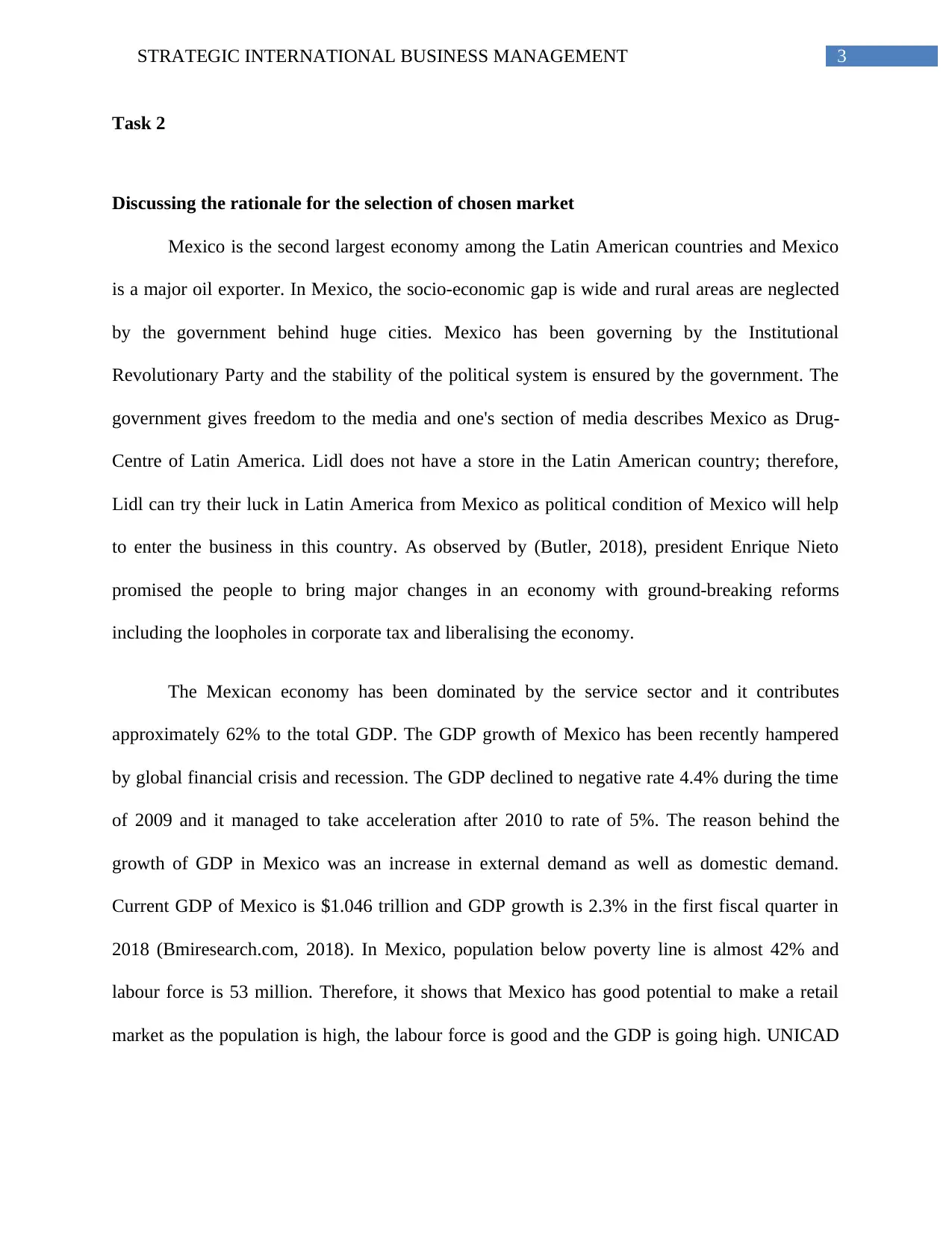
3STRATEGIC INTERNATIONAL BUSINESS MANAGEMENT
Task 2
Discussing the rationale for the selection of chosen market
Mexico is the second largest economy among the Latin American countries and Mexico
is a major oil exporter. In Mexico, the socio-economic gap is wide and rural areas are neglected
by the government behind huge cities. Mexico has been governing by the Institutional
Revolutionary Party and the stability of the political system is ensured by the government. The
government gives freedom to the media and one's section of media describes Mexico as Drug-
Centre of Latin America. Lidl does not have a store in the Latin American country; therefore,
Lidl can try their luck in Latin America from Mexico as political condition of Mexico will help
to enter the business in this country. As observed by (Butler, 2018), president Enrique Nieto
promised the people to bring major changes in an economy with ground-breaking reforms
including the loopholes in corporate tax and liberalising the economy.
The Mexican economy has been dominated by the service sector and it contributes
approximately 62% to the total GDP. The GDP growth of Mexico has been recently hampered
by global financial crisis and recession. The GDP declined to negative rate 4.4% during the time
of 2009 and it managed to take acceleration after 2010 to rate of 5%. The reason behind the
growth of GDP in Mexico was an increase in external demand as well as domestic demand.
Current GDP of Mexico is $1.046 trillion and GDP growth is 2.3% in the first fiscal quarter in
2018 (Bmiresearch.com, 2018). In Mexico, population below poverty line is almost 42% and
labour force is 53 million. Therefore, it shows that Mexico has good potential to make a retail
market as the population is high, the labour force is good and the GDP is going high. UNICAD
Task 2
Discussing the rationale for the selection of chosen market
Mexico is the second largest economy among the Latin American countries and Mexico
is a major oil exporter. In Mexico, the socio-economic gap is wide and rural areas are neglected
by the government behind huge cities. Mexico has been governing by the Institutional
Revolutionary Party and the stability of the political system is ensured by the government. The
government gives freedom to the media and one's section of media describes Mexico as Drug-
Centre of Latin America. Lidl does not have a store in the Latin American country; therefore,
Lidl can try their luck in Latin America from Mexico as political condition of Mexico will help
to enter the business in this country. As observed by (Butler, 2018), president Enrique Nieto
promised the people to bring major changes in an economy with ground-breaking reforms
including the loopholes in corporate tax and liberalising the economy.
The Mexican economy has been dominated by the service sector and it contributes
approximately 62% to the total GDP. The GDP growth of Mexico has been recently hampered
by global financial crisis and recession. The GDP declined to negative rate 4.4% during the time
of 2009 and it managed to take acceleration after 2010 to rate of 5%. The reason behind the
growth of GDP in Mexico was an increase in external demand as well as domestic demand.
Current GDP of Mexico is $1.046 trillion and GDP growth is 2.3% in the first fiscal quarter in
2018 (Bmiresearch.com, 2018). In Mexico, population below poverty line is almost 42% and
labour force is 53 million. Therefore, it shows that Mexico has good potential to make a retail
market as the population is high, the labour force is good and the GDP is going high. UNICAD
Paraphrase This Document
Need a fresh take? Get an instant paraphrase of this document with our AI Paraphraser
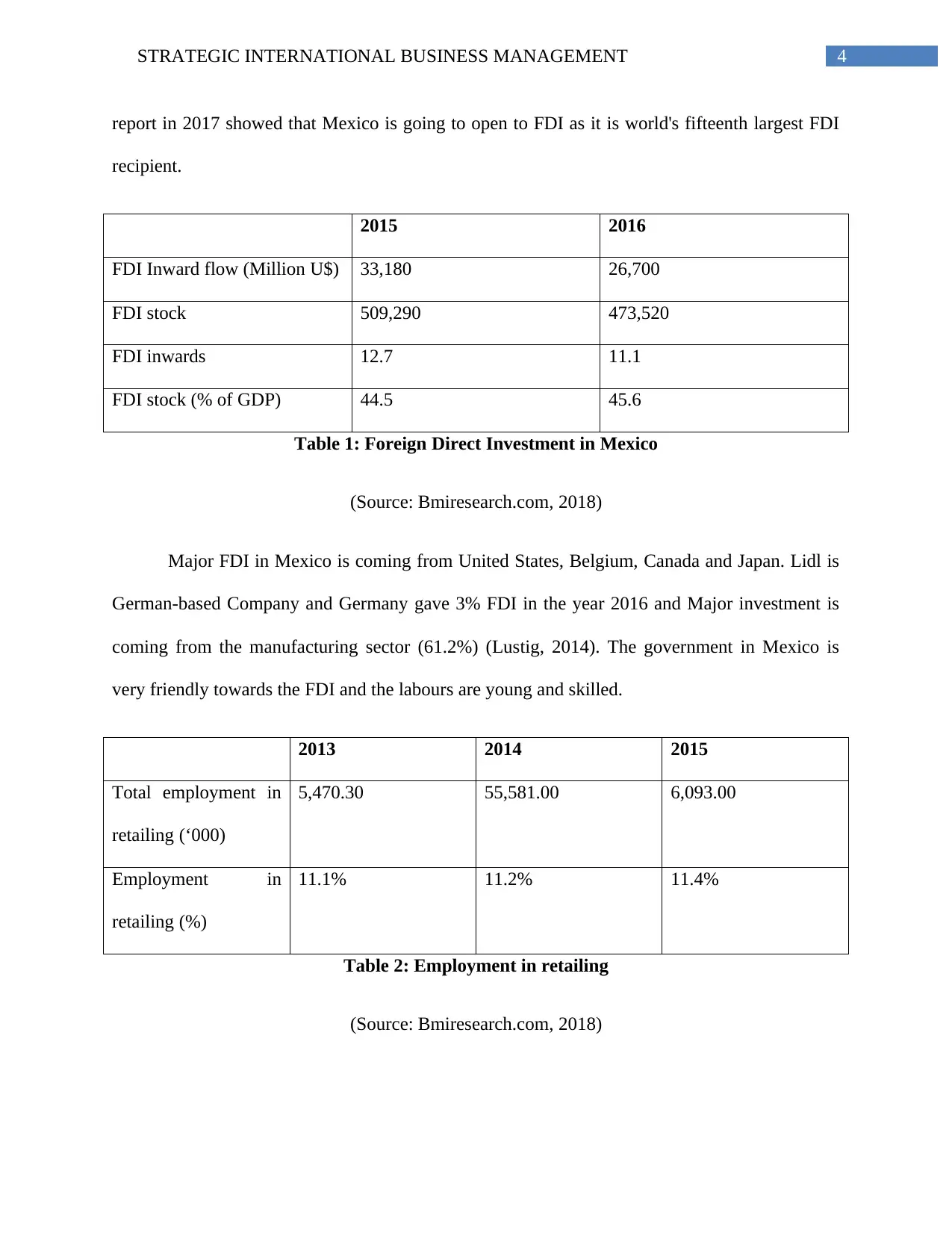
4STRATEGIC INTERNATIONAL BUSINESS MANAGEMENT
report in 2017 showed that Mexico is going to open to FDI as it is world's fifteenth largest FDI
recipient.
2015 2016
FDI Inward flow (Million U$) 33,180 26,700
FDI stock 509,290 473,520
FDI inwards 12.7 11.1
FDI stock (% of GDP) 44.5 45.6
Table 1: Foreign Direct Investment in Mexico
(Source: Bmiresearch.com, 2018)
Major FDI in Mexico is coming from United States, Belgium, Canada and Japan. Lidl is
German-based Company and Germany gave 3% FDI in the year 2016 and Major investment is
coming from the manufacturing sector (61.2%) (Lustig, 2014). The government in Mexico is
very friendly towards the FDI and the labours are young and skilled.
2013 2014 2015
Total employment in
retailing (‘000)
5,470.30 55,581.00 6,093.00
Employment in
retailing (%)
11.1% 11.2% 11.4%
Table 2: Employment in retailing
(Source: Bmiresearch.com, 2018)
report in 2017 showed that Mexico is going to open to FDI as it is world's fifteenth largest FDI
recipient.
2015 2016
FDI Inward flow (Million U$) 33,180 26,700
FDI stock 509,290 473,520
FDI inwards 12.7 11.1
FDI stock (% of GDP) 44.5 45.6
Table 1: Foreign Direct Investment in Mexico
(Source: Bmiresearch.com, 2018)
Major FDI in Mexico is coming from United States, Belgium, Canada and Japan. Lidl is
German-based Company and Germany gave 3% FDI in the year 2016 and Major investment is
coming from the manufacturing sector (61.2%) (Lustig, 2014). The government in Mexico is
very friendly towards the FDI and the labours are young and skilled.
2013 2014 2015
Total employment in
retailing (‘000)
5,470.30 55,581.00 6,093.00
Employment in
retailing (%)
11.1% 11.2% 11.4%
Table 2: Employment in retailing
(Source: Bmiresearch.com, 2018)
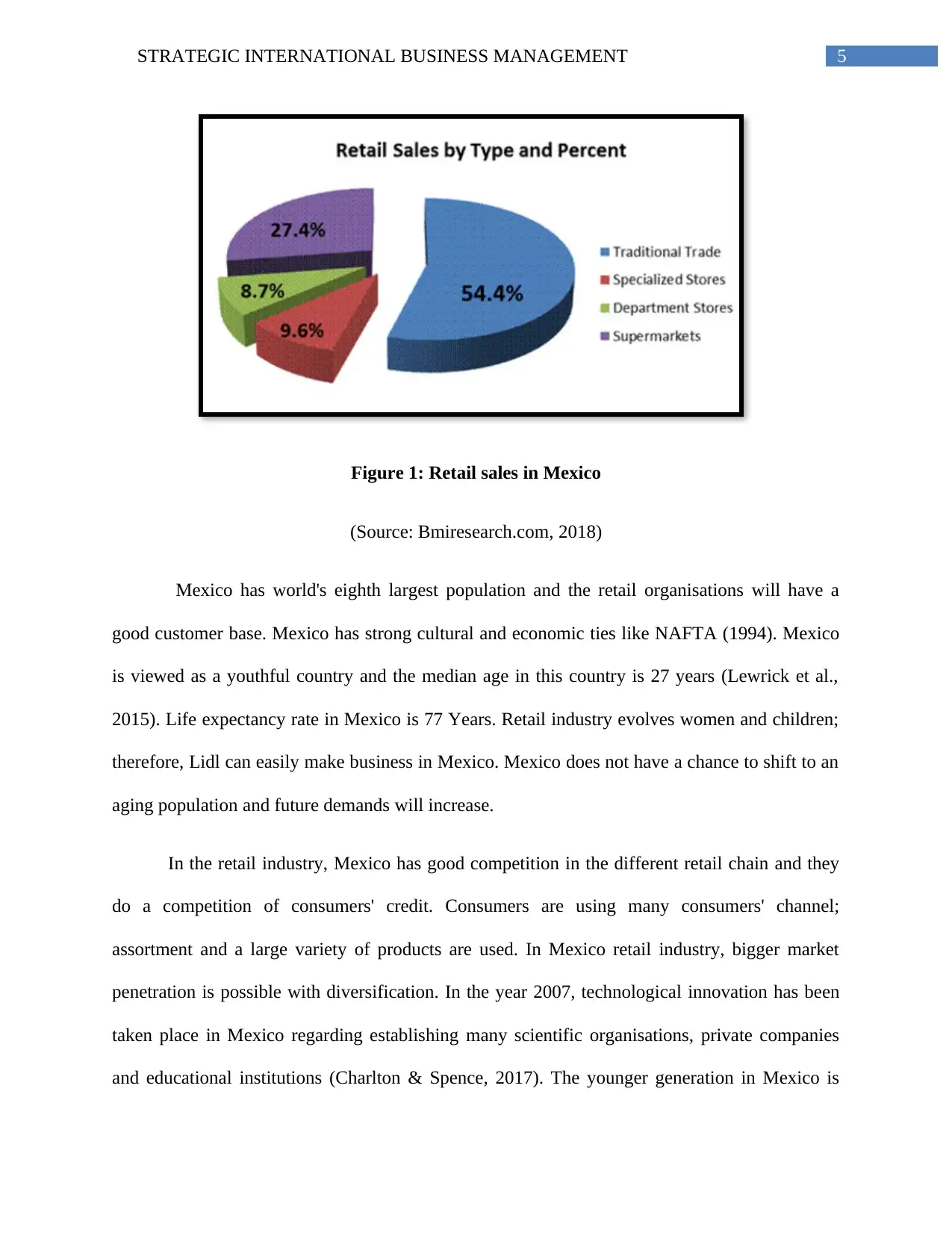
5STRATEGIC INTERNATIONAL BUSINESS MANAGEMENT
Figure 1: Retail sales in Mexico
(Source: Bmiresearch.com, 2018)
Mexico has world's eighth largest population and the retail organisations will have a
good customer base. Mexico has strong cultural and economic ties like NAFTA (1994). Mexico
is viewed as a youthful country and the median age in this country is 27 years (Lewrick et al.,
2015). Life expectancy rate in Mexico is 77 Years. Retail industry evolves women and children;
therefore, Lidl can easily make business in Mexico. Mexico does not have a chance to shift to an
aging population and future demands will increase.
In the retail industry, Mexico has good competition in the different retail chain and they
do a competition of consumers' credit. Consumers are using many consumers' channel;
assortment and a large variety of products are used. In Mexico retail industry, bigger market
penetration is possible with diversification. In the year 2007, technological innovation has been
taken place in Mexico regarding establishing many scientific organisations, private companies
and educational institutions (Charlton & Spence, 2017). The younger generation in Mexico is
Figure 1: Retail sales in Mexico
(Source: Bmiresearch.com, 2018)
Mexico has world's eighth largest population and the retail organisations will have a
good customer base. Mexico has strong cultural and economic ties like NAFTA (1994). Mexico
is viewed as a youthful country and the median age in this country is 27 years (Lewrick et al.,
2015). Life expectancy rate in Mexico is 77 Years. Retail industry evolves women and children;
therefore, Lidl can easily make business in Mexico. Mexico does not have a chance to shift to an
aging population and future demands will increase.
In the retail industry, Mexico has good competition in the different retail chain and they
do a competition of consumers' credit. Consumers are using many consumers' channel;
assortment and a large variety of products are used. In Mexico retail industry, bigger market
penetration is possible with diversification. In the year 2007, technological innovation has been
taken place in Mexico regarding establishing many scientific organisations, private companies
and educational institutions (Charlton & Spence, 2017). The younger generation in Mexico is
⊘ This is a preview!⊘
Do you want full access?
Subscribe today to unlock all pages.

Trusted by 1+ million students worldwide

6STRATEGIC INTERNATIONAL BUSINESS MANAGEMENT
very interested to learn about technologies. In retail, the organisations are using internet and
Internet contributes to 1% to GDP.
Civil law in Mexico is depended on the legal system that based on legal principles and
codified law. In FDI, Mexico allows the 100% investment in retailing and the President of
Mexico has continued to restructure the FDIO system (Donelson & Esparza, 2016). It would
benefit Lidl to start the business in Mexico. If any foreign company want to start a business in
Mexico, it would subject to the same tax category as national enterprises. The government in
Mexico does not impose an extra tax for the foreign investment and average 2% to 4% is the
highest value of the transaction in the fair market value.
In Mexico
Number of tax payment per year 6.0
Time is taken for administrative formalities
(hours)
286.0
The total share of taxes 52.0
Table 3: Corporate taxation in Mexico
(Source: Pwc.com, 2018)
In the retail industry of discount store, the organisations have to follow the environmental
policies. Under Mexican law, air and waste must be taken care of. The retail industry is emitting
hazardous waste, products and speciality (Bennet & Sharpe, 2014). Sustainability is the policy of
reducing the environmental impacts that may reduce the regulatory requirements and risks as
well as reputation improvement. Mexican laws urge the companies to use sustainable energy in
order to avoid the penalties.
very interested to learn about technologies. In retail, the organisations are using internet and
Internet contributes to 1% to GDP.
Civil law in Mexico is depended on the legal system that based on legal principles and
codified law. In FDI, Mexico allows the 100% investment in retailing and the President of
Mexico has continued to restructure the FDIO system (Donelson & Esparza, 2016). It would
benefit Lidl to start the business in Mexico. If any foreign company want to start a business in
Mexico, it would subject to the same tax category as national enterprises. The government in
Mexico does not impose an extra tax for the foreign investment and average 2% to 4% is the
highest value of the transaction in the fair market value.
In Mexico
Number of tax payment per year 6.0
Time is taken for administrative formalities
(hours)
286.0
The total share of taxes 52.0
Table 3: Corporate taxation in Mexico
(Source: Pwc.com, 2018)
In the retail industry of discount store, the organisations have to follow the environmental
policies. Under Mexican law, air and waste must be taken care of. The retail industry is emitting
hazardous waste, products and speciality (Bennet & Sharpe, 2014). Sustainability is the policy of
reducing the environmental impacts that may reduce the regulatory requirements and risks as
well as reputation improvement. Mexican laws urge the companies to use sustainable energy in
order to avoid the penalties.
Paraphrase This Document
Need a fresh take? Get an instant paraphrase of this document with our AI Paraphraser
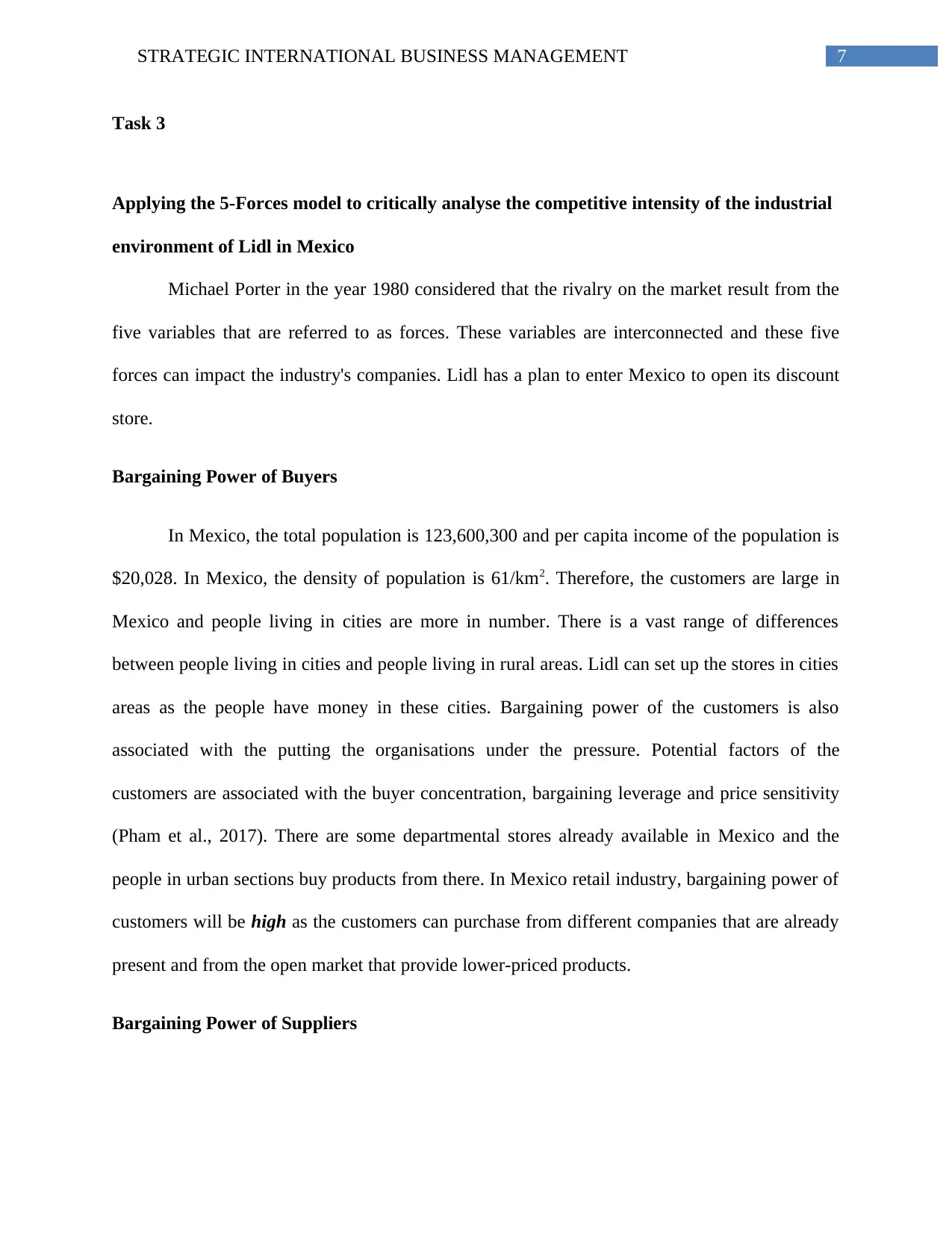
7STRATEGIC INTERNATIONAL BUSINESS MANAGEMENT
Task 3
Applying the 5-Forces model to critically analyse the competitive intensity of the industrial
environment of Lidl in Mexico
Michael Porter in the year 1980 considered that the rivalry on the market result from the
five variables that are referred to as forces. These variables are interconnected and these five
forces can impact the industry's companies. Lidl has a plan to enter Mexico to open its discount
store.
Bargaining Power of Buyers
In Mexico, the total population is 123,600,300 and per capita income of the population is
$20,028. In Mexico, the density of population is 61/km2. Therefore, the customers are large in
Mexico and people living in cities are more in number. There is a vast range of differences
between people living in cities and people living in rural areas. Lidl can set up the stores in cities
areas as the people have money in these cities. Bargaining power of the customers is also
associated with the putting the organisations under the pressure. Potential factors of the
customers are associated with the buyer concentration, bargaining leverage and price sensitivity
(Pham et al., 2017). There are some departmental stores already available in Mexico and the
people in urban sections buy products from there. In Mexico retail industry, bargaining power of
customers will be high as the customers can purchase from different companies that are already
present and from the open market that provide lower-priced products.
Bargaining Power of Suppliers
Task 3
Applying the 5-Forces model to critically analyse the competitive intensity of the industrial
environment of Lidl in Mexico
Michael Porter in the year 1980 considered that the rivalry on the market result from the
five variables that are referred to as forces. These variables are interconnected and these five
forces can impact the industry's companies. Lidl has a plan to enter Mexico to open its discount
store.
Bargaining Power of Buyers
In Mexico, the total population is 123,600,300 and per capita income of the population is
$20,028. In Mexico, the density of population is 61/km2. Therefore, the customers are large in
Mexico and people living in cities are more in number. There is a vast range of differences
between people living in cities and people living in rural areas. Lidl can set up the stores in cities
areas as the people have money in these cities. Bargaining power of the customers is also
associated with the putting the organisations under the pressure. Potential factors of the
customers are associated with the buyer concentration, bargaining leverage and price sensitivity
(Pham et al., 2017). There are some departmental stores already available in Mexico and the
people in urban sections buy products from there. In Mexico retail industry, bargaining power of
customers will be high as the customers can purchase from different companies that are already
present and from the open market that provide lower-priced products.
Bargaining Power of Suppliers
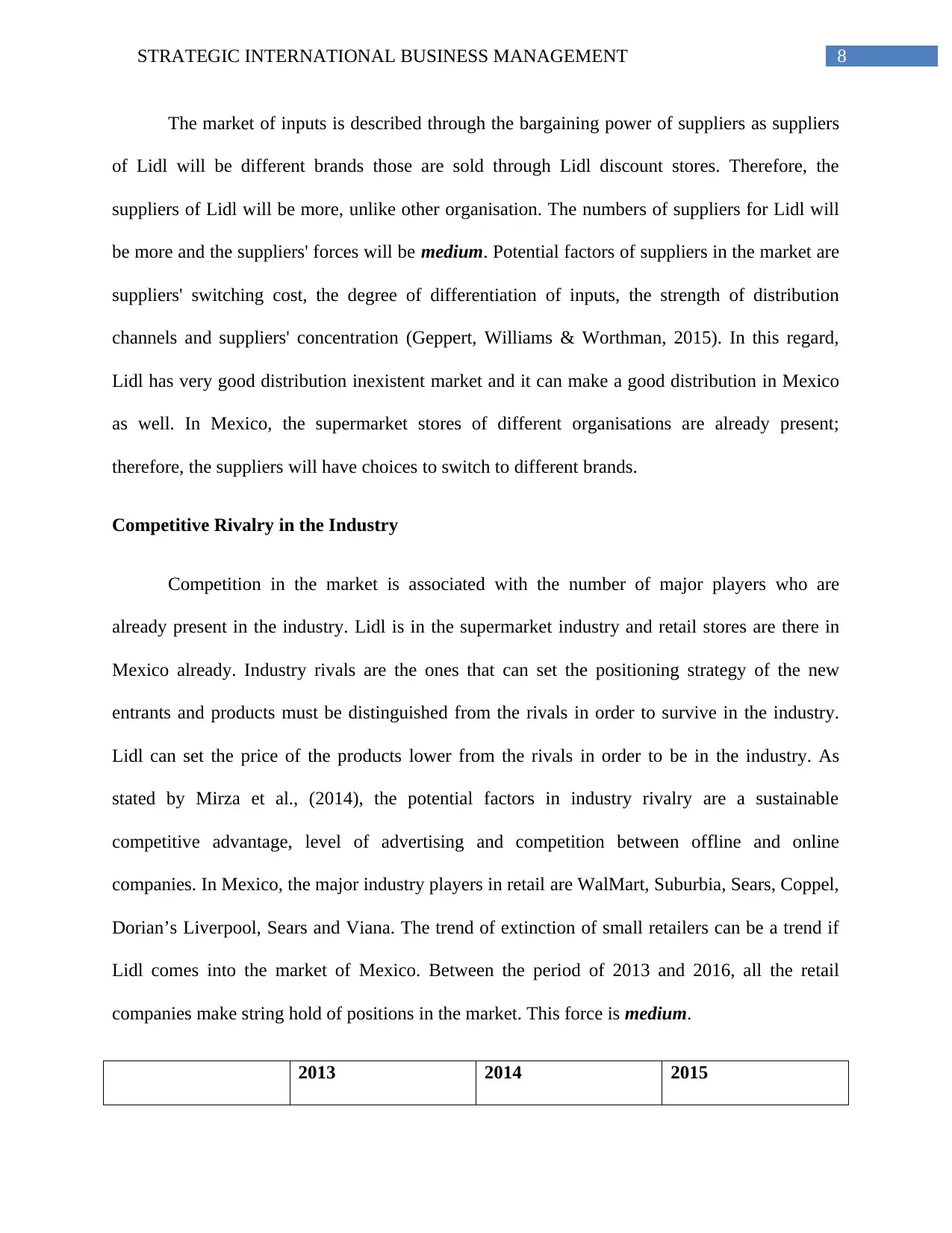
8STRATEGIC INTERNATIONAL BUSINESS MANAGEMENT
The market of inputs is described through the bargaining power of suppliers as suppliers
of Lidl will be different brands those are sold through Lidl discount stores. Therefore, the
suppliers of Lidl will be more, unlike other organisation. The numbers of suppliers for Lidl will
be more and the suppliers' forces will be medium. Potential factors of suppliers in the market are
suppliers' switching cost, the degree of differentiation of inputs, the strength of distribution
channels and suppliers' concentration (Geppert, Williams & Worthman, 2015). In this regard,
Lidl has very good distribution inexistent market and it can make a good distribution in Mexico
as well. In Mexico, the supermarket stores of different organisations are already present;
therefore, the suppliers will have choices to switch to different brands.
Competitive Rivalry in the Industry
Competition in the market is associated with the number of major players who are
already present in the industry. Lidl is in the supermarket industry and retail stores are there in
Mexico already. Industry rivals are the ones that can set the positioning strategy of the new
entrants and products must be distinguished from the rivals in order to survive in the industry.
Lidl can set the price of the products lower from the rivals in order to be in the industry. As
stated by Mirza et al., (2014), the potential factors in industry rivalry are a sustainable
competitive advantage, level of advertising and competition between offline and online
companies. In Mexico, the major industry players in retail are WalMart, Suburbia, Sears, Coppel,
Dorian’s Liverpool, Sears and Viana. The trend of extinction of small retailers can be a trend if
Lidl comes into the market of Mexico. Between the period of 2013 and 2016, all the retail
companies make string hold of positions in the market. This force is medium.
2013 2014 2015
The market of inputs is described through the bargaining power of suppliers as suppliers
of Lidl will be different brands those are sold through Lidl discount stores. Therefore, the
suppliers of Lidl will be more, unlike other organisation. The numbers of suppliers for Lidl will
be more and the suppliers' forces will be medium. Potential factors of suppliers in the market are
suppliers' switching cost, the degree of differentiation of inputs, the strength of distribution
channels and suppliers' concentration (Geppert, Williams & Worthman, 2015). In this regard,
Lidl has very good distribution inexistent market and it can make a good distribution in Mexico
as well. In Mexico, the supermarket stores of different organisations are already present;
therefore, the suppliers will have choices to switch to different brands.
Competitive Rivalry in the Industry
Competition in the market is associated with the number of major players who are
already present in the industry. Lidl is in the supermarket industry and retail stores are there in
Mexico already. Industry rivals are the ones that can set the positioning strategy of the new
entrants and products must be distinguished from the rivals in order to survive in the industry.
Lidl can set the price of the products lower from the rivals in order to be in the industry. As
stated by Mirza et al., (2014), the potential factors in industry rivalry are a sustainable
competitive advantage, level of advertising and competition between offline and online
companies. In Mexico, the major industry players in retail are WalMart, Suburbia, Sears, Coppel,
Dorian’s Liverpool, Sears and Viana. The trend of extinction of small retailers can be a trend if
Lidl comes into the market of Mexico. Between the period of 2013 and 2016, all the retail
companies make string hold of positions in the market. This force is medium.
2013 2014 2015
⊘ This is a preview!⊘
Do you want full access?
Subscribe today to unlock all pages.

Trusted by 1+ million students worldwide
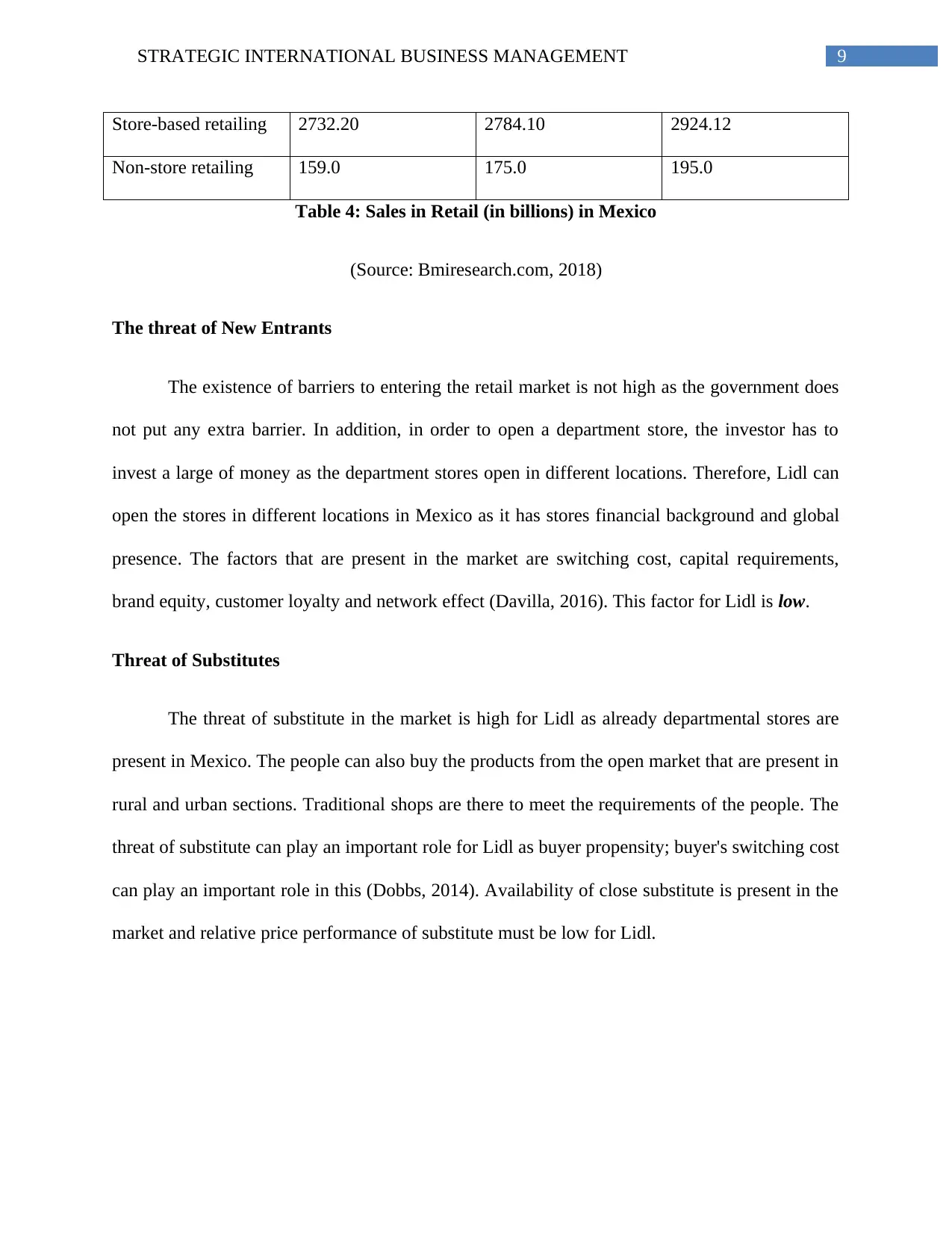
9STRATEGIC INTERNATIONAL BUSINESS MANAGEMENT
Store-based retailing 2732.20 2784.10 2924.12
Non-store retailing 159.0 175.0 195.0
Table 4: Sales in Retail (in billions) in Mexico
(Source: Bmiresearch.com, 2018)
The threat of New Entrants
The existence of barriers to entering the retail market is not high as the government does
not put any extra barrier. In addition, in order to open a department store, the investor has to
invest a large of money as the department stores open in different locations. Therefore, Lidl can
open the stores in different locations in Mexico as it has stores financial background and global
presence. The factors that are present in the market are switching cost, capital requirements,
brand equity, customer loyalty and network effect (Davilla, 2016). This factor for Lidl is low.
Threat of Substitutes
The threat of substitute in the market is high for Lidl as already departmental stores are
present in Mexico. The people can also buy the products from the open market that are present in
rural and urban sections. Traditional shops are there to meet the requirements of the people. The
threat of substitute can play an important role for Lidl as buyer propensity; buyer's switching cost
can play an important role in this (Dobbs, 2014). Availability of close substitute is present in the
market and relative price performance of substitute must be low for Lidl.
Store-based retailing 2732.20 2784.10 2924.12
Non-store retailing 159.0 175.0 195.0
Table 4: Sales in Retail (in billions) in Mexico
(Source: Bmiresearch.com, 2018)
The threat of New Entrants
The existence of barriers to entering the retail market is not high as the government does
not put any extra barrier. In addition, in order to open a department store, the investor has to
invest a large of money as the department stores open in different locations. Therefore, Lidl can
open the stores in different locations in Mexico as it has stores financial background and global
presence. The factors that are present in the market are switching cost, capital requirements,
brand equity, customer loyalty and network effect (Davilla, 2016). This factor for Lidl is low.
Threat of Substitutes
The threat of substitute in the market is high for Lidl as already departmental stores are
present in Mexico. The people can also buy the products from the open market that are present in
rural and urban sections. Traditional shops are there to meet the requirements of the people. The
threat of substitute can play an important role for Lidl as buyer propensity; buyer's switching cost
can play an important role in this (Dobbs, 2014). Availability of close substitute is present in the
market and relative price performance of substitute must be low for Lidl.
Paraphrase This Document
Need a fresh take? Get an instant paraphrase of this document with our AI Paraphraser
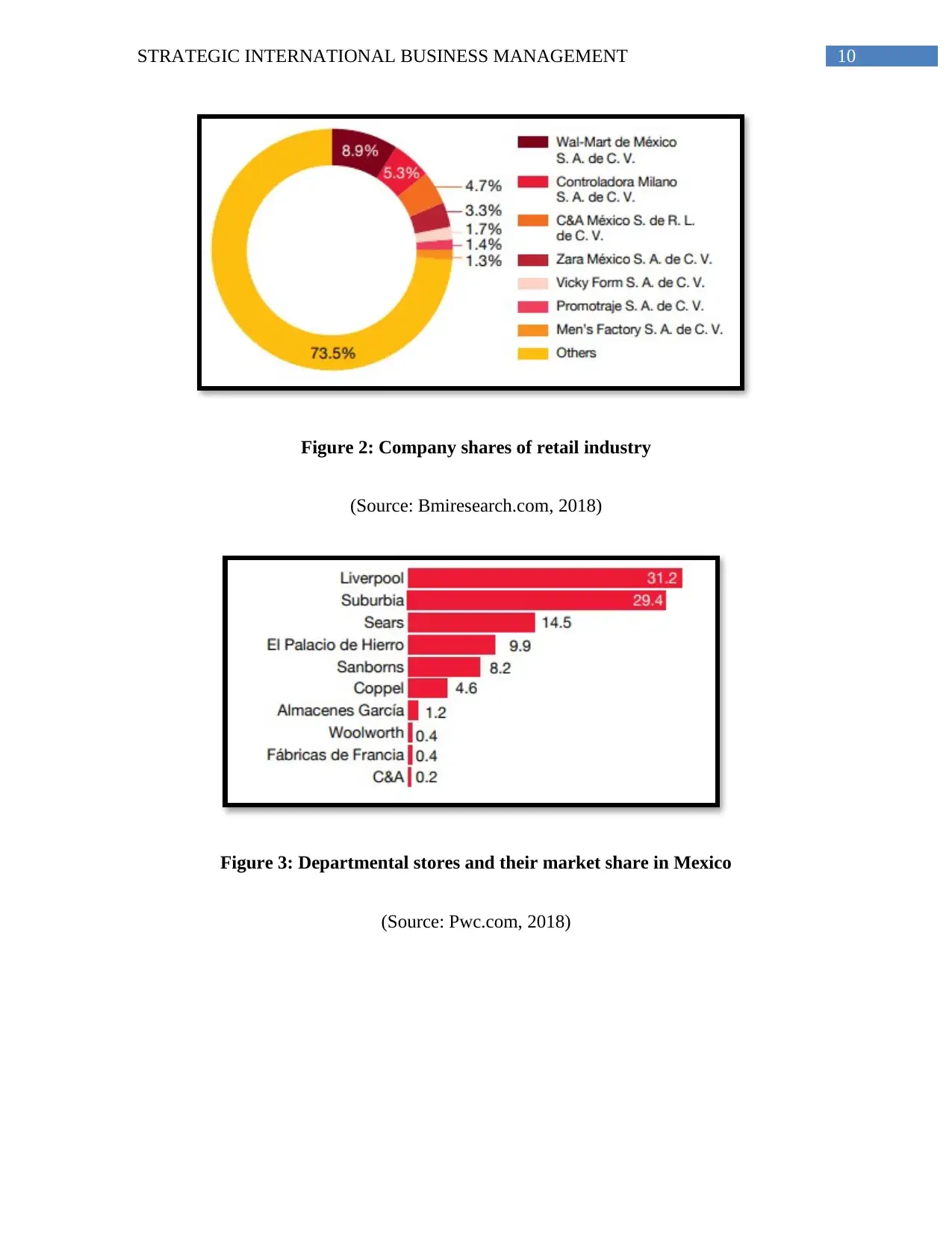
10STRATEGIC INTERNATIONAL BUSINESS MANAGEMENT
Figure 2: Company shares of retail industry
(Source: Bmiresearch.com, 2018)
Figure 3: Departmental stores and their market share in Mexico
(Source: Pwc.com, 2018)
Figure 2: Company shares of retail industry
(Source: Bmiresearch.com, 2018)
Figure 3: Departmental stores and their market share in Mexico
(Source: Pwc.com, 2018)
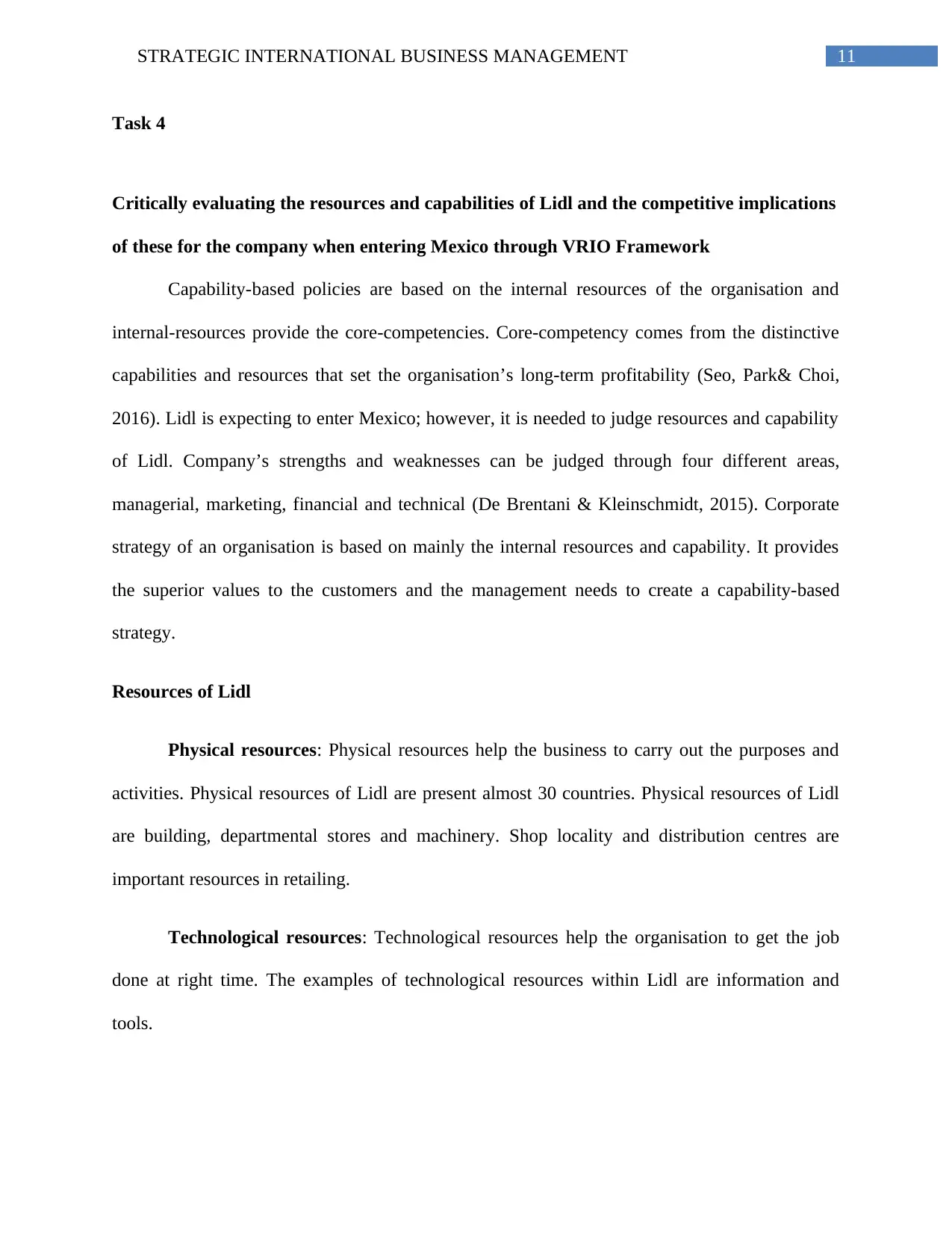
11STRATEGIC INTERNATIONAL BUSINESS MANAGEMENT
Task 4
Critically evaluating the resources and capabilities of Lidl and the competitive implications
of these for the company when entering Mexico through VRIO Framework
Capability-based policies are based on the internal resources of the organisation and
internal-resources provide the core-competencies. Core-competency comes from the distinctive
capabilities and resources that set the organisation’s long-term profitability (Seo, Park& Choi,
2016). Lidl is expecting to enter Mexico; however, it is needed to judge resources and capability
of Lidl. Company’s strengths and weaknesses can be judged through four different areas,
managerial, marketing, financial and technical (De Brentani & Kleinschmidt, 2015). Corporate
strategy of an organisation is based on mainly the internal resources and capability. It provides
the superior values to the customers and the management needs to create a capability-based
strategy.
Resources of Lidl
Physical resources: Physical resources help the business to carry out the purposes and
activities. Physical resources of Lidl are present almost 30 countries. Physical resources of Lidl
are building, departmental stores and machinery. Shop locality and distribution centres are
important resources in retailing.
Technological resources: Technological resources help the organisation to get the job
done at right time. The examples of technological resources within Lidl are information and
tools.
Task 4
Critically evaluating the resources and capabilities of Lidl and the competitive implications
of these for the company when entering Mexico through VRIO Framework
Capability-based policies are based on the internal resources of the organisation and
internal-resources provide the core-competencies. Core-competency comes from the distinctive
capabilities and resources that set the organisation’s long-term profitability (Seo, Park& Choi,
2016). Lidl is expecting to enter Mexico; however, it is needed to judge resources and capability
of Lidl. Company’s strengths and weaknesses can be judged through four different areas,
managerial, marketing, financial and technical (De Brentani & Kleinschmidt, 2015). Corporate
strategy of an organisation is based on mainly the internal resources and capability. It provides
the superior values to the customers and the management needs to create a capability-based
strategy.
Resources of Lidl
Physical resources: Physical resources help the business to carry out the purposes and
activities. Physical resources of Lidl are present almost 30 countries. Physical resources of Lidl
are building, departmental stores and machinery. Shop locality and distribution centres are
important resources in retailing.
Technological resources: Technological resources help the organisation to get the job
done at right time. The examples of technological resources within Lidl are information and
tools.
⊘ This is a preview!⊘
Do you want full access?
Subscribe today to unlock all pages.

Trusted by 1+ million students worldwide
1 out of 26
Related Documents
Your All-in-One AI-Powered Toolkit for Academic Success.
+13062052269
info@desklib.com
Available 24*7 on WhatsApp / Email
![[object Object]](/_next/static/media/star-bottom.7253800d.svg)
Unlock your academic potential
Copyright © 2020–2026 A2Z Services. All Rights Reserved. Developed and managed by ZUCOL.





